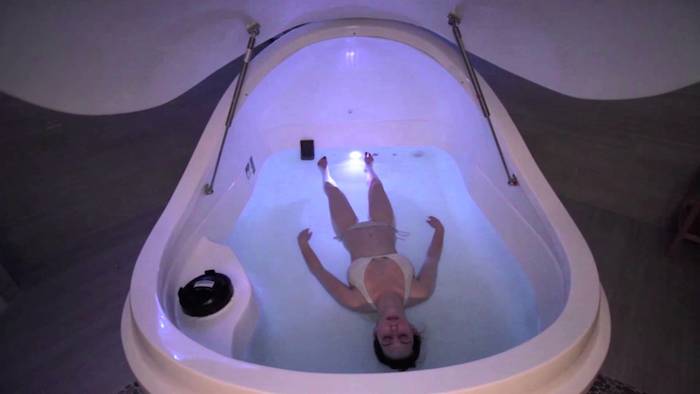
In the last handful of years, float tanks have bubbled up to the surface of our consciousness.
By now you may have heard about people shedding their clothes, taking a dip and uncovering what’s within.
If you haven’t heard of tanks just yet, then welcome to total relaxation. Also known as the sensory deprivation tank, or isolation tank, the floatation tank was developed by psychonaut John C. Lilly in 1954, who was testing the hypothesis: if stimuli was cut off to the brain, then the brain would fall asleep.
After many personal experiments in the tank, Lilly realized that he created a space for consciousness exploration, not necessarily brain sleep. Lilly’s lifelong work included experimenting with drugs, writing books about his tank experiences, and we can’t forget that he was funded by NASA to see if he could get dolphins to speak. If you remember the Sega game Ecco the Dolphin, then you’ve already encountered the fascinating mind of John C. Lilly.
Lilly’s float tank can be described as a healing tool used for relaxation, meditation and consciousness exploration. Large enough to house an adult lying down, the tank is filled with about a foot of water saturated with about 700 pounds of Epsom salt. The water and air temperature are set to the temperature of your skin. With these combined factors, you are able to experience floating.
Years ago when I first experienced floating, I had a hallucinogenic, spiritual breakthrough. I even had a flashback of being in the womb. So, when I got ready for a recent float, I mentally prepared myself to not expect anything, so I would be ready to receive anything that was coming my way.
So maybe you’re interesting in floating, but you’re not sure what to expect.
Don’t expect anything, and remain open to welcome your best results. From my meditation and floating experience, I’ve compiled my best insights on how to get the most out of your float:
Begin a Daily Practice of Yoga and/or Meditation
The ancient practices of yoga and meditation have stood the test of time with good reason. Not until we look within, do we realize how wild our minds really are. Get a grip on your mind by sticking to a daily practice. Start now if you haven’t already. It is best to float from a centered viewpoint.
Develop a Breathing Practice That Works for You
When the breath is calm, the brain is calm, and the body is calm. The breath can be used to link the mind and the body. The breathing practice that works best for me and my students is Three Part Breath or Dirga Pranayama. See the directions for this Pranayama at the end of this article.
Watch From Behind Your Eyes
Let your perspective shift back as if you are perceiving from behind your eyes. A meditation practice I picked up, and never put down, this technique primes your mental state to receive anything that is to come your way. When you’re traveling through consciousness, you never know what you’ll find! In my experience, it is best to train yourself to not be overtaken by astonishment. Be cool, and just watch!
Find a Mantra
A mantra can be an amazing tool to keep your mind from running away with thoughts. Know the multiple meanings of your mantra, and know the definition of the words, too.
My two favorite mantras:
Om Namo Bhagavate Vasudevaya and Om Mani Padme Hum.
Stretch!
During my first float, I focused so much on my mind-space that it wasn’t until the end of my float session that I realized, “It feels great to stretch in here!” Move around and tune in to your senses. Extract poses from your yoga practice, or move with your natural flow. Once we stretch out, we are able to relax in.
Find a pose that will allow you to stretch in all directions: it feels amazing to release tight connective tissues!
Visualize Your Spine Lengthening
After practicing the breathing technique, centering my mind, and stretching my body, I realized that I could use my breath and awareness to lengthen my spine. Imagine that each vertebrae is gently floating, rather than being compressed with gravity, then breathe length into your spine.
Visualize Your Chakras Shining & Aligning
If you haven’t already, learn the chakra system beforehand. Starting at the lowest chakra, place your awareness on each chakra center while visualizing the corresponding chakra color. I have practiced this technique numerous times over the years, and this practice has produced some of the best visions I have ever received.
Feel Love, Gratitude, Compassion & Connection
Coming in contact with the deepest layers of ourselves is the perfect time to realize that we are all One. If we are able to open our hearts while we simultaneously dissolve our boundaries (possible to achieve due to the tank’s setting), there’s a chance we can open to something much larger than our singular perception. Quieting the mind, and opening the heart is a beautiful practice.
Know the Stages
Know that for the first 10 minutes or so, you won’t be centered just yet. Be easy with yourself as you let go, and allow for any random jolts: your foot might bump the edge of the tank, or a drop of water might land on your head. Don’t get discouraged, this uptightness will pass.
Also, do whatever you need to do to get comfortable. I prefer to place my hair into a bun on top of my head to prevent the weight of my hair from straining my neck. Maybe you’d like to place the provided pool noodle behind your neck, or possibly the earplugs will suit your needs. Get comfy!
As you continue to quiet your mind, thoughts will start to creep in. Don’t worry, that’s why you’ve been practicing meditation. Use your breath and mantra to dampen these thoughts.
Then it comes: you’re floating, quietly. This is the time to relax into yourself. Trying to make visualizations appear is not going to make them happen. Breathe into your expansion, and drink it up.
Lastly, visualizations may occur.
Hopefully your breathing and focusing practices will give you enough juice to stimulate a little endogenous DMT production. Watch from behind your eyes, and enjoy the show. Bring a notebook or have a voice recording app on your phone to record your experience afterwards. If you don’t record your experience, share it with someone. The sooner you repeat your experience, the more likely you’ll retain it.
Feel Good While You’re in the Tank
All too often we are trying to achieve an end product when we really should simply be enjoying ourselves.
Take it easy, relax, and sink deeper into the present.
Enjoy your float!
Three Part Breath or Dirga Pranayama
Step 1: Begin by bringing your awareness to your belly. Place your hand on your belly, and notice the breath expanding here on your inhalation. Your belly and hand will lift just a bit.
Step 2: Exhale, and feel your belly deflate.
Step 3: After a few rounds of breath in this fashion, notice your belly rise, and then your lower lungs expand as well on the inhale.
Step 4: On the exhale, allow the lower lungs to fall, then the belly falls.
Step 5: After a few rounds of this bigger breath, on the inhalation: belly rises, lower lungs rise, and then upper lungs all become inflated.
Step 6: As you exhale, deflating: upper lungs, lower lungs, belly.
The more you practice this technique, the more you can get lost in your breath. Use this style of breathing all throughout the float to help keep your mind focused and your body relaxed.
Author: Christine Spencer
Editor: Renée Picard
Image: Youtube screenshot











Read 0 comments and reply